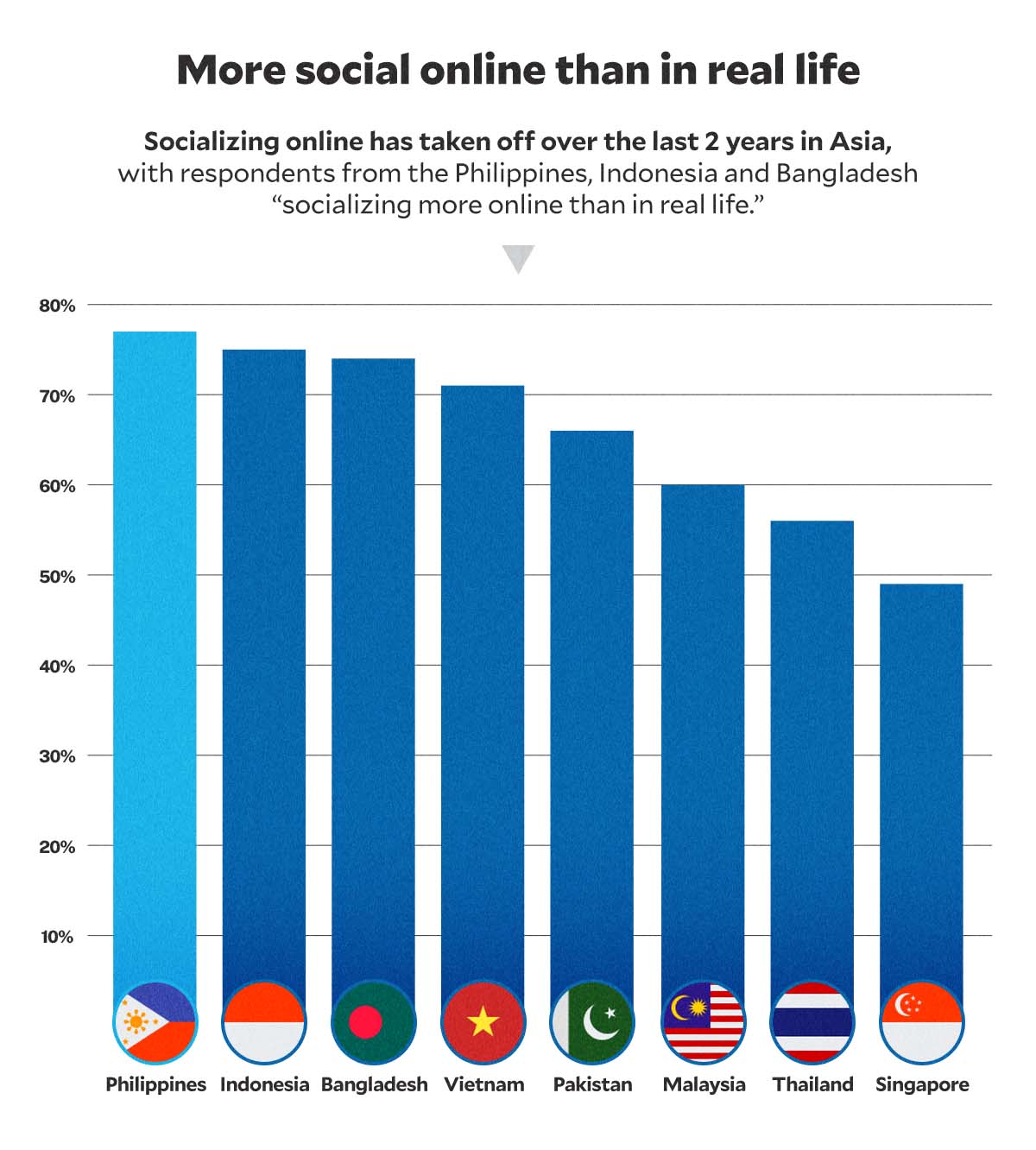PH social media craze: 77% of Filipinos more engaging online than in real life
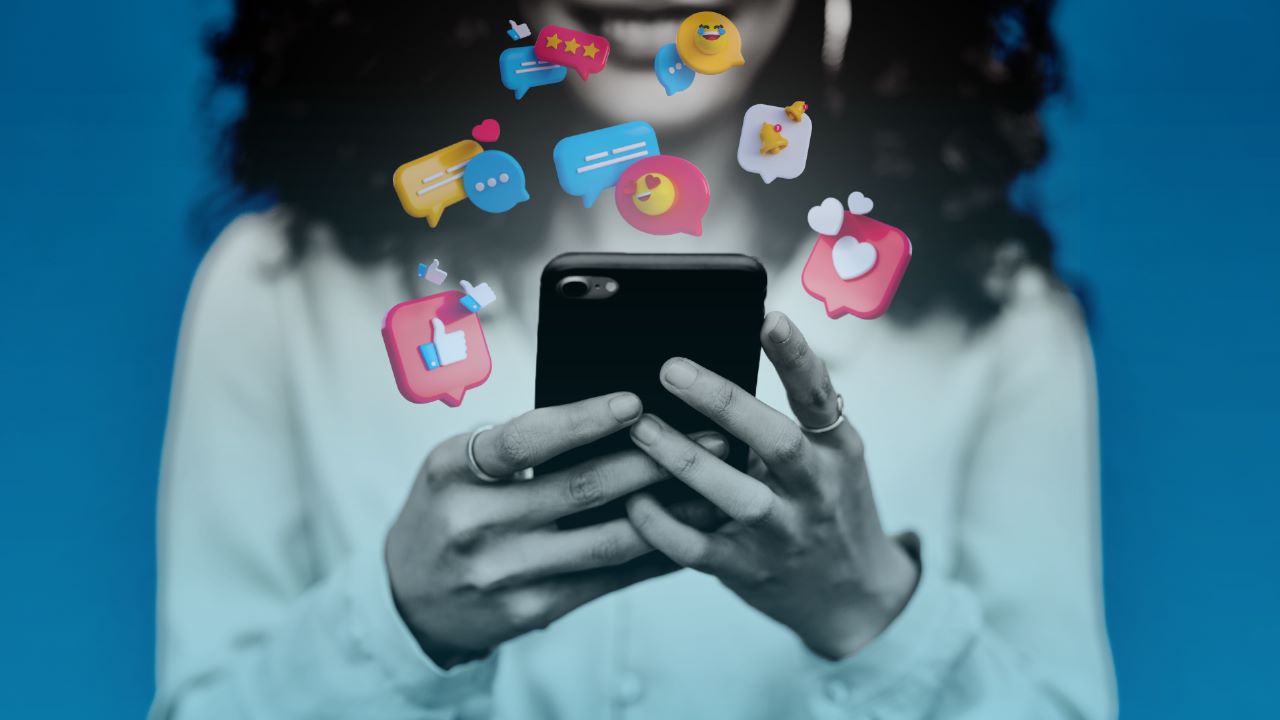
INQUIRER FILE PHOTO/DANIELLA MARIE AGACER
MANILA, Philippines—As the COVID-19 crisis restricted most activities in the last two years, socializing online has taken off, especially in the Philippines, where 77 percent of the population has become more engaging online than in real life.
Telenor Asia, an international telecommunications company, said this on Tuesday (Jan. 31) as it released the findings of its study, Digital Lives Decoded, that surveyed 8,000 consumers across eight markets in South and Southeast Asia.
Based on the results of the study, socializing online has “strengthened connections between people,” stressing that overall, 66 percent of respondents engage more online than in real life.
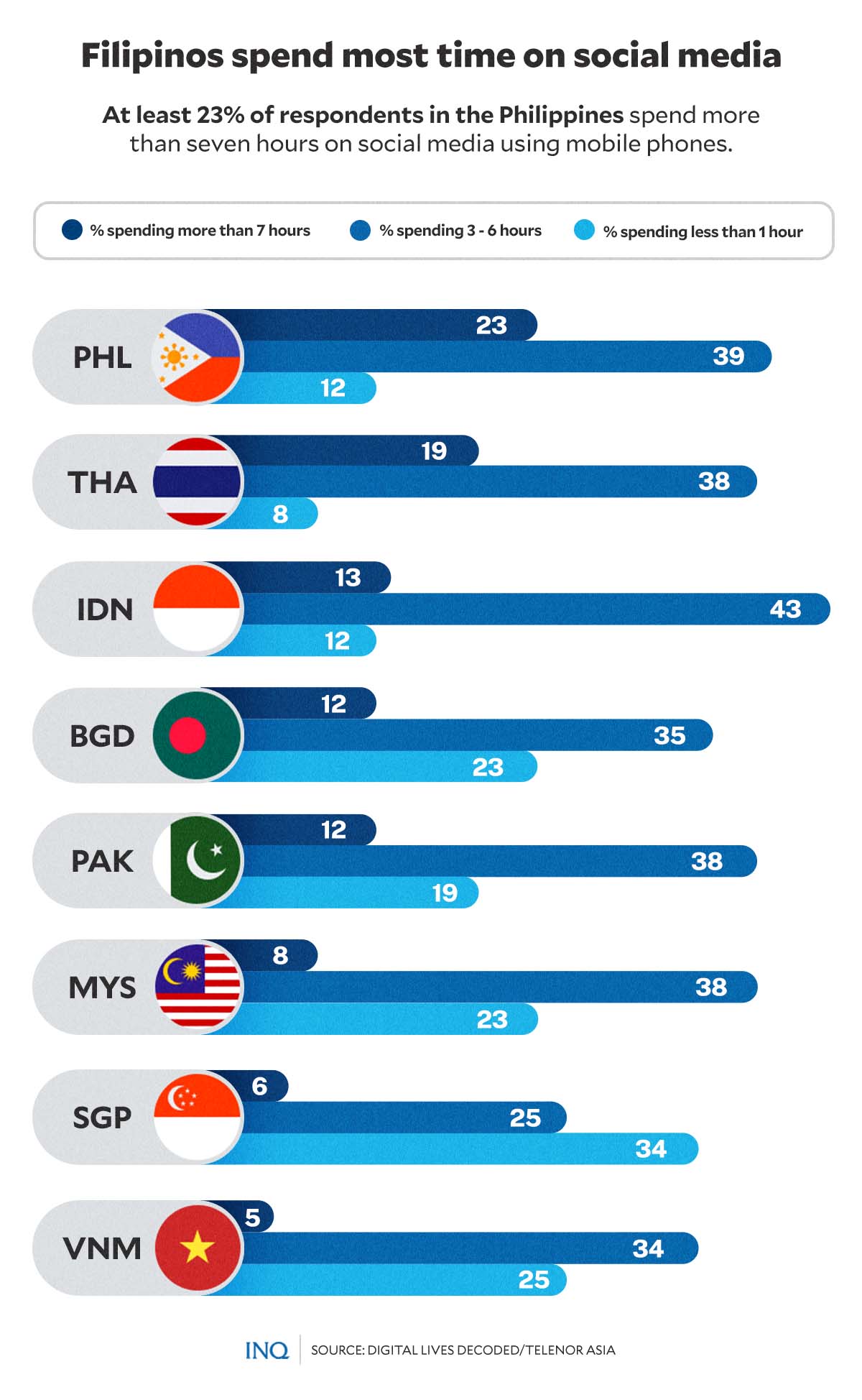
GRAPHIC Ed Lustan
Filipino consumers are the “most virtually social” at 77 percent. Next are respondents from Indonesia (75 percent), Bangladesh (74 percent), Vietnam (71 percent), Pakistan (66 percent), Malaysia (60 percent), and Thailand (56 percent).
As pointed out by Jørgen C. Arentz Rostrup, head of Telenor Asia, some of the habits formed in the over two years of the COVID-19 crisis “are becoming hard-wired in the way we live our lives today.”
READ: Filipinos remain most active internet, social media users globally — study
“Younger generations tend to spend more time socializing online, but Baby Boomers (people who were born after World War II) say that mobile technology is helping them feel more connected to their loved ones,” he said.
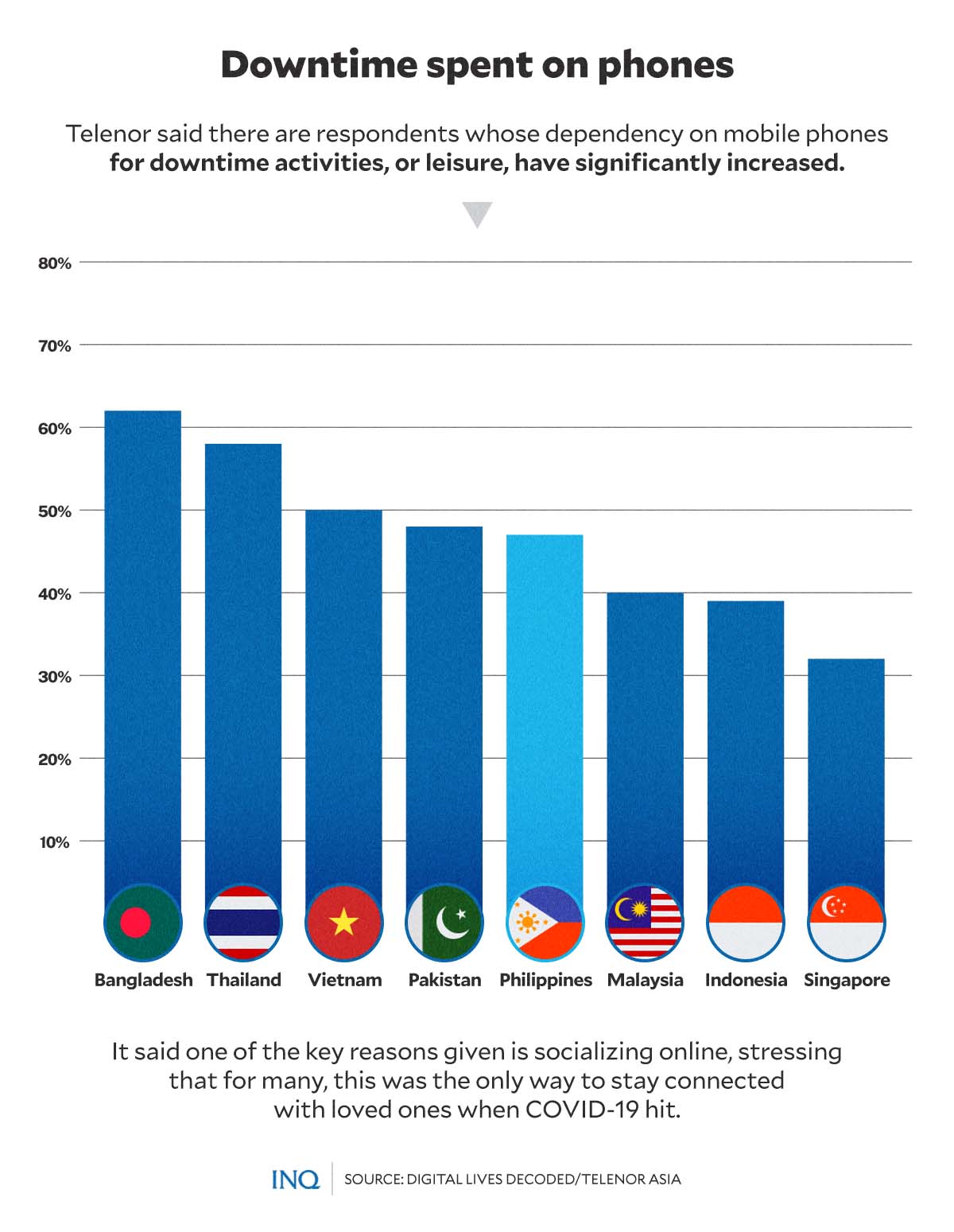
GRAPHIC Ed Lustan
This, as 55 percent of the respondents said mobile technology is helping them feel more connected to people they know, with Thailand topping the list at 63 percent, followed by Bangladesh (61 percent), and the Philippines (58 percent).
When it comes to respondents saying that they regularly meet new people online, Thailand is still first on the list with 66 percent, while the Philippines is second to the last with 39 percent.
Downtime mostly spent on phones
Telenor Asia said in previous reports, “we have seen the role mobile connectivity has played in helping people supercharge their careers and earning potential as well as how it improves daily life.”
However, as the pandemic started taking a heavy toll on people’s lives in 2020, nine in 10 respondents are more dependent on their mobile phones for leisure now than two years ago.
RELATED STORY: Survey: Filipinos connected to social media almost 4 hours daily
It stressed that almost half—47 percent—said their reliance has increased significantly, while 42 percent said it somewhat increased. Only 10 percent said their dependence on mobiles did not change.
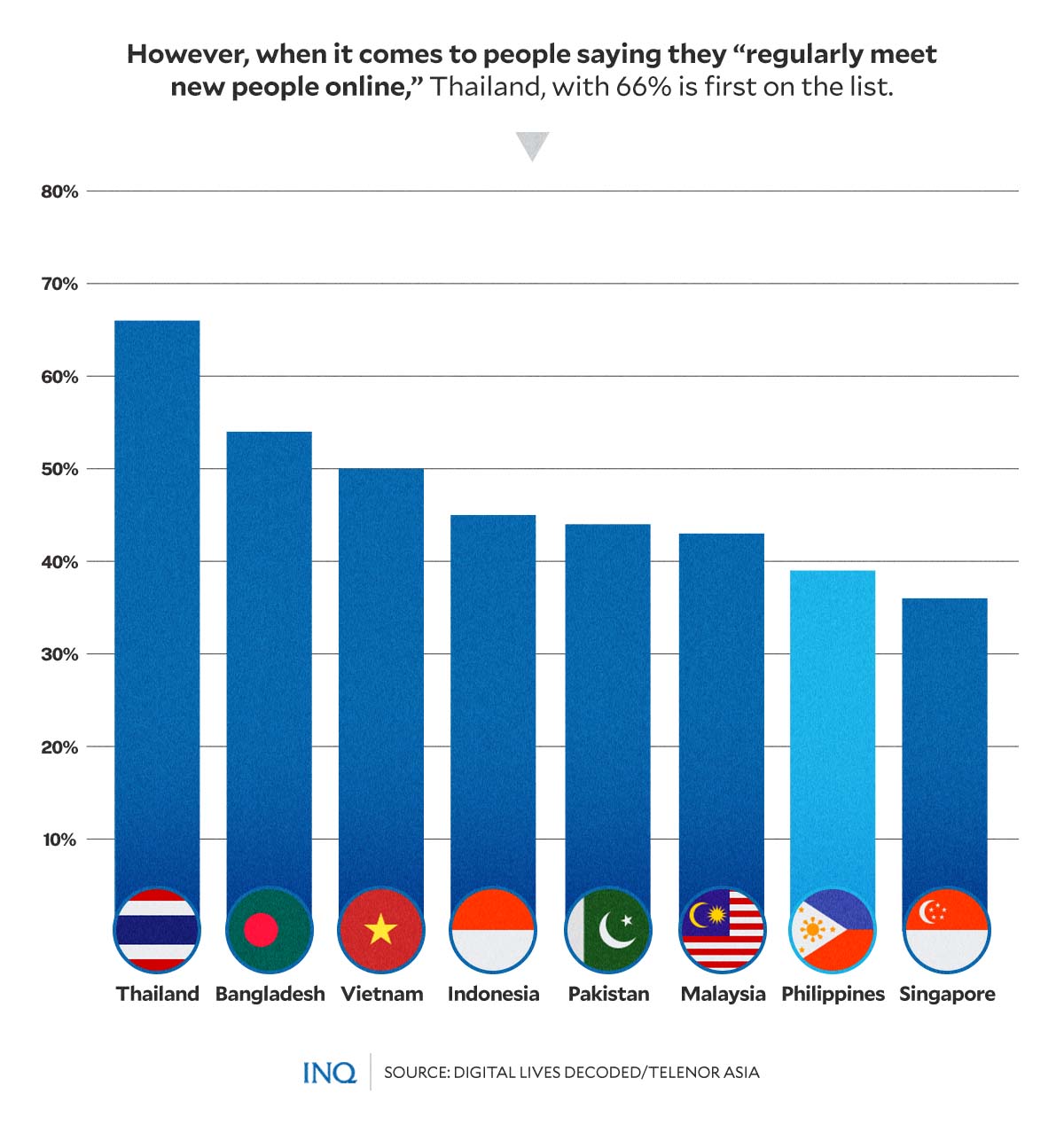
GRAPHIC Ed Lustan
Based on the results of the study, consumers from Bangladesh have the highest reliance at 62 percent, followed by Thailand (58 percent), Vietnam (50 percent) and Pakistan (48 percent).
At least 47 percent of respondents from the Philippines said their dependence on their mobile phones for downtime activities have significantly increased, while 42 percent said it somewhat increased. Some 11 percent said there was no change.
Telenor Asia pointed out that one of the key reasons for this is socializing online because for a lot of people, this was the only way to stay connected with loved ones when the health crisis brought the world to a standstill.
But it stressed that while social media have become the mainstay of people’s downtime, “it is not the only use of their mobile phones as respondents are increasingly looking to their devices for personal upskilling (sic) and development.”
This, as 40 percent said they use mobile phones to tap into learning and educational applications or websites, with women and younger generations most likely to experience the benefits.
Telenor Asia said some 82 percent believe that these learning opportunities “positively impact their quality of life,” which is reflected by 45 percent of respondents who spend at least an hour a day listening to podcasts.
Filipinos spend most time on social media
According to the international telecommunications company, Filipinos take the most time engaging in social media using mobile phones, with 23 percent of consumers, which is the highest in the region, spending more than seven hours a day.
Trailing the Philippines is Thailand, with 19 percent of consumers spending seven hours a day. Next are Indonesia (13 percent), Bangladesh (12 percent), Pakistan (12 percent), Malaysia (8 percent), Singapore (6 percent), and Vietnam (5 percent).
The Philippines, meanwhile, is second to Indonesia when it comes to the percentage of respondents who spend three to six hours a day engaging online—39 percent against 43 percent.
Some 38 percent of consumers each in Pakistan, Malaysia and Thailand likewise spend three to six hours a day, Telenor Asia said, stressing that out of the overall 36 percent, most are millennials and Gen Z at 39 percent and 36 percent, respectively.
Based on results of the study, only 12 percent of consumers in the Philippines spend less than an hour engaging in social media using mobile phones, the second lowest in the region, next to Thailand’s 8 percent.
Looking back, the Digital 2022 report of social media management firm Hootsuite and creative agency We Are Social stated that on average, internet users aged 16 to 64 all over the world spend an average of six hours and 58 minutes using the internet each day.
READ: Social media, internet craze keep PH on top 2 of world list
Then based on the findings, internet users in the Philippines in the same age range spent an average of 10 hours and 27 minutes connected to the internet each day last year.
The figure was lower compared to the 2021 data which found that Filipinos spent an average of 10 hours and 56 minutes connected to the internet, making it then the top country that has the most active internet users all over the world.
What to expect in next 2 years
Telenor Asia said “all generations expect to increase time spent on social media in the next two years,” especially on social media, alternative investments, and online social gaming.
RELATED STORY: PH is world leader in social media usage
It said 80 percent of consumers each in the Philippines, Vietnam and Indonesia will spend more time on their mobile phones to engage with people through social media. Next were Thailand (77 percent) and Bangladesh (75 percent).
When it comes to online social gaming, 46 percent of respondents from the Philippines said they will spend more time on their mobile phones for this purpose, Telenor Asia said. Thailand topped the list with 62 percent.
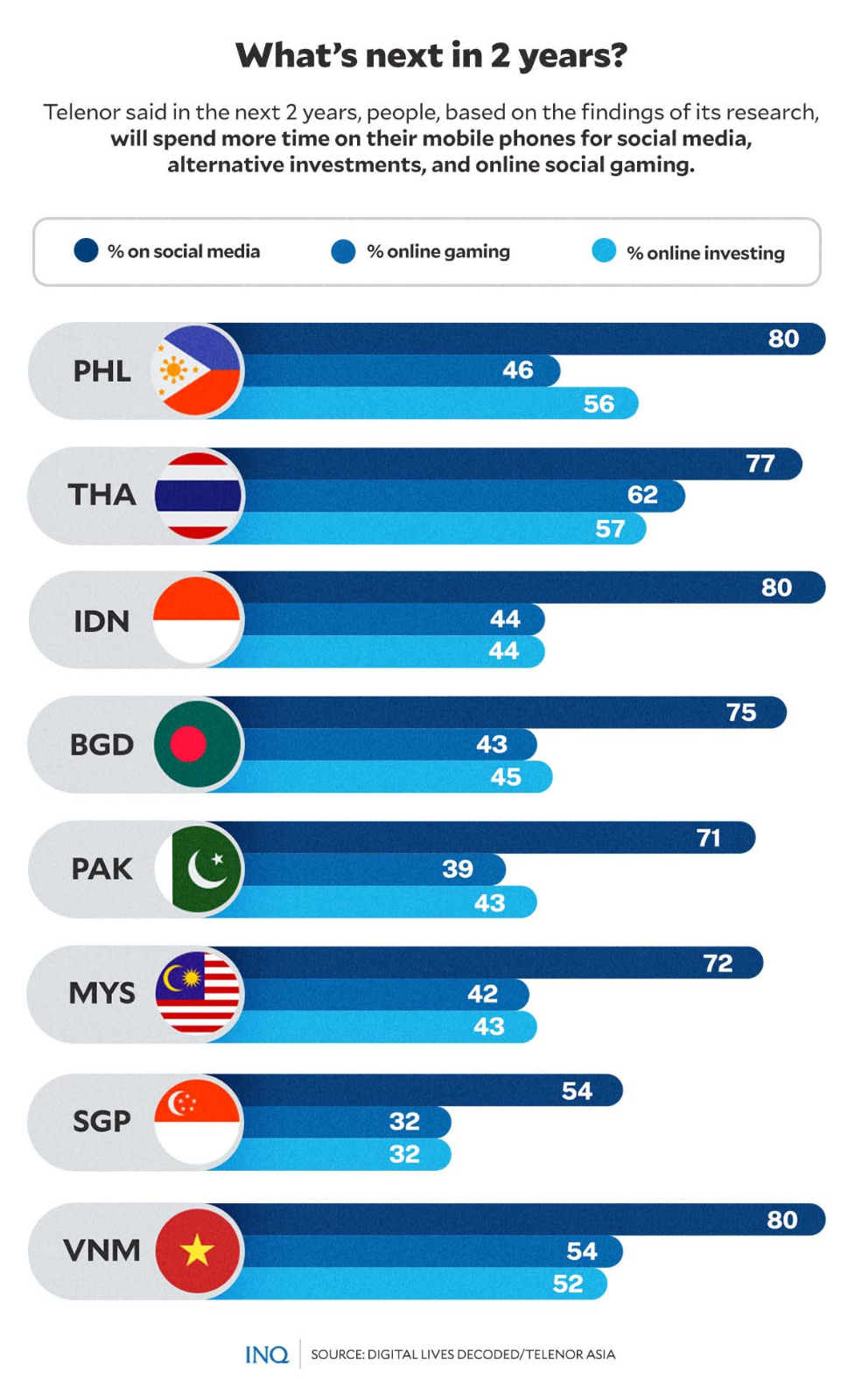
GRAPHIC Ed Lustan
At least 56 percent of Filipino consumers, meanwhile, will dedicate more time for alternative investments, next to Thailand, where 57 percent will use their mobile phones more often to invest.
“Contrary to widely-held beliefs, mobile phones do not detract us from having social lives. In fact, people point to the positive impact of mobile phones on their lives,” the telecommunications company said.
This, as 93 percent said mobile phones improve their lives, 82 percent stated that it enables greater connectivity with friends, family, and colleagues, and 57 percent said it is a source of personal entertainment.
“Modern mobile phone users have grown up with social media, therefore it should be no surprise that many of our apps and habits are inherently bound to social usage,” Telenor Asia said.
It stressed that people are using mobile technology to connect more with loved ones, keeping open the channels of communication even when they cannot physically be together.
“As Asia steadily becomes a more urban society with younger generations moving away from their more rural homes, this is a trend that will help bind families and friends together.”
Challenges ahead
But as more people are expected to stay on social media, Rostrup said “this growth comes with even higher expectations of mobile operators as people seek more dependable, faster mobile networks.”
“The trends from this Digital Lives Decoded study highlight the opportunity for operators to expand beyond the traditional towards new capabilities and services, becoming not only an enabler of the technology but also a partner in the virtual world,” according to Rostrup.
Likewise, as Filipino consumers were said to be the most “virtually social,” calls for the government and telecommunications companies to strengthen cybersecurity have become more relevant than ever.
This, as a study from e-security firm Kaspersky urged the Philippine government to take “a more active stance in prioritizing cybersecurity against the backdrop of constantly evolving cyber threats.”
While Kaspersky stressed that data leaks in Singapore and Australia are by far the largest when looking at the weighted gross domestic amounts of orders, the Philippines has one of the highest counts of dark web advertisements that are indicating an attack executed.
READ: PH cybercrime vulnerability among highest, says cybersecurity firm
An attack executed, it said, is the initial access broker activity on the dark web, which is an overlay network, where insiders sell access to a network, and malware logs with domain credentials.
